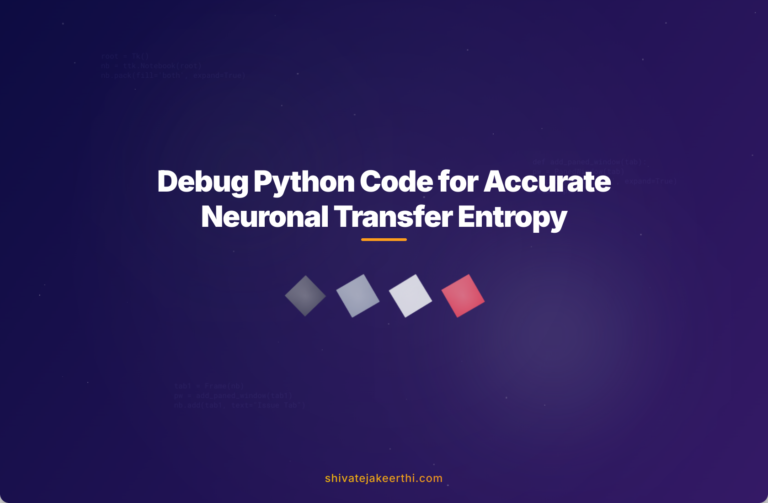If you’re working on analyzing interactions between neurons, chances are you’ve come across transfer entropy. This metric helps understand directional information flow, crucial for neuroscience research, especially when assessing how neuron signals predict one another.
Recently, a researcher reached out with a puzzling issue in their Python implementation of transfer entropy. Their goal was clear: measure how one neuron’s activity predicts another, but something was off—the prediction direction appeared reversed.
This blog tackles precisely that issue: debugging prediction direction problems in calculating transfer entropy with Python. Let’s clarify the concepts, spot the errors, and fix them step-by-step.
Understanding Transfer Entropy Calculation
Transfer entropy is a measure of directionality in information flow. Think of it as asking, “Can knowing about Neuron A’s past help me predict Neuron B’s next move?” It quantifies the dependence of one neuron’s current state on the past behavior of another neuron—essentially finding causal links between neurons.
In neuroscience, getting this measurement right is critical. Incorrect calculations might falsely suggest reversed or absent relationships between neuronal activities. That’s why accuracy is key.
To perform this analysis, you probably created or found a Python function that processes two neuronal firing rate vectors. Typically, transfer entropy (TE) calculation involves discretizing neuronal signals, forming joint probability distributions, and computing conditional entropies.
One common parameter you’ll encounter is L, the embedding length, or the “lag,” which defines how far back you’re looking over the neuronal signals to make predictions. L influences how your probabilities and conditional entropies are structured, so choosing and implementing it correctly matters.
Identifying the Error
Our researcher noticed suspicious results: sometimes transfer entropy values hinted the opposite direction of causality compared to biological expectations. For example, a neuron they expected as the input appeared as the output. Clearly, incorrect TE calculations can lead to faulty conclusions in research.
Identifying exactly where the error arose in the Python script was critical. Was the discretization faulty? Did joint probability matrices PY_joint or PXY form incorrectly? Or did conditioning and normalization steps introduce bugs influencing directional interpretation?
Step-by-Step Debugging to Solve the Issue
Let’s carefully revisit each step in the Python function:
Step 1: Discretization of Time-Series Data
First, neuronal activity, often continuous firing rates or voltage signals, must be discretized. Typically, you use histogram binning. For example:
import numpy as np
data_discretized, bins = np.histogram(data, bins=5)
Ensure bins match neuronal data characteristics. Poor discretization can skew conditional probabilities used later. Confirm your discretized series correctly represent original neuronal signals.
Step 2: Constructing Joint Probability Matrices (PY_joint and PXY)
At the heart of TE calculation are joint and conditional probability distributions. Let’s consider X (input neuron) and Y (output neuron).
Previously, this is possibly where the confusion arose:
- PY_joint should contain joint probabilities of Y at time t with its past history.
- PXY involves X at past times and Y, to observe whether past X improves the prediction of Y.
Careful indexing is critical. Suppose you originally had:
PY_joint = np.histogram2d(Y[t:], Y[t-L:t])[0]
PXY = np.histogramdd((Y[t:], Y[t-L:t], X[t-L:t]))[0]
If arrays are mis-aligned or index-shifted incorrectly, you risk reversing prediction directions. Carefully check your indices; Python arrays start at zero, and shifting errors often happen here.
Step 3: Normalizing and Calculating Conditional Entropies
Probabilities must sum to one. Ensure clear normalization at each stage:
PY_joint /= np.sum(PY_joint)
PXY /= np.sum(PXY)
Calculate Conditional Entropies carefully:
- H(Y | Y_past)
- H(Y | Y_past, X_past)
Initially, your code might mix conditions, reversing causality. Clearly distinguish between predictor (X_past) and target (Y) indices:
H_conditional_Y_given_Ypast = -np.nansum(PY_joint*np.log2(PY_joint/PY_past))
H_conditional_Y_given_Ypast_Xpast = -np.nansum(PXY*np.log2(PXY/PXY_past))
TransferEntropy = H_conditional_Y_given_Ypast - H_conditional_Y_given_Ypast_Xpast
Ensure the predictor (X_past) is correctly referenced as influencing the target neuron Y’s current state.
Evaluating Your Corrected Function
After debugging these pitfalls, test your revised transfer entropy script with known synthetic neuron data first (where you control directionality explicitly):
- Check whether neurons with known connectivity return positive TE values for correct directions.
- Compare old (faulty) results to new ones, confirming clarity in prediction direction.
Suppose you previously got:
| TE(Neuron1 → Neuron2) | -0.03 |
| TE(Neuron2 → Neuron1) | 0.15 |
After correction, expect clearer results aligning biologically:
| TE(Neuron1 → Neuron2) | 0.12 |
| TE(Neuron2 → Neuron1) | 0.01 |
Consistent directional results confirm you’ve addressed the problem.
Leveraging Existing GitHub Resources
Sometimes, inspecting existing open-source repositories can expedite debugging. The researcher shared a GitHub repository—making it easy to study organized, peer-reviewed Python scripts.
Check the defined functions and implementations clearly laid out by peers. Observe how the professional structuring can guide your own code refinement. If issues persist, communicating in the repository issues section often attracts valuable external collaboration.
Feel confident reaching out through platforms like Stack Overflow. Community input accelerates resolution of niche debugging problems in Python.
Keep Exploring and Learning Together
Resolving these transfer entropy calculation issues might have felt challenging initially, but systematically debugging leads to robust, trustworthy results. Ensuring accurate prediction directionality significantly enhances neuroscientific analyses.
Utilize available Python-based resources like dit package or SciPy’s entropy methods. Check online tutorials (like those available under this Python category) for helpful tips and additional example implementations to strengthen your coding practices.
Ready to dive deeper into your neuronal analysis? What further issues have you encountered with Python-based neuroscience methods? Drop your thoughts below—let’s keep learning together!



0 Comments